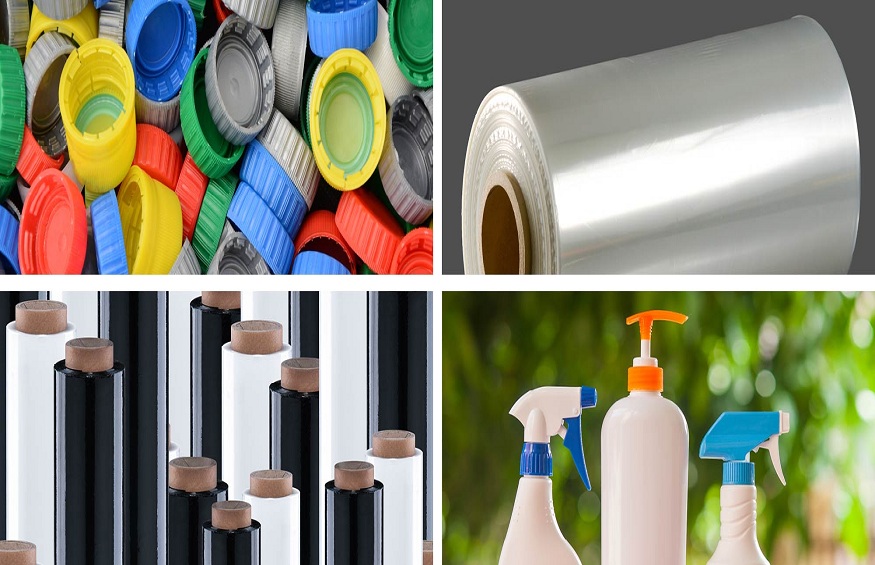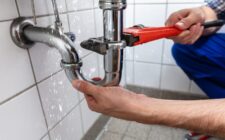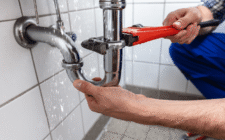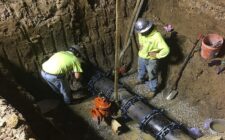Before converting polyvinyl chloride (PVC) resin into a thermoplastic melt, it must be thoroughly mixed with suitable additives.
Dry Blend Mixing
Dry blends are primarily powder blends obtained by mixing Suspension PVC (S-PVC) resin and other compounding ingredients together.
High-Intensity
High-speed batch mixing followed by a cooling stage is the preferred method for producing rigid PVC (PVC-U) and corresponding flexible PVC (PVC-P) dry blends in high production volumes.
Low Intensity
A low-speed, near-shear-free horizontal mixer provides gentler product handling, evenly dispersing all ingredients without altering particle identity. The walls of the mixer, jacketed for heating and cooling, bring the bulk material back to the center. This creates a continuous splitting and recombination of the material. Centrifugal force is sufficient to throw material particles into free space where they collide with other particles. This breaks up agglomerates. This technique is typically used for cold mixing and heating to help absorb the plasticizer.
liquid PVC mixture
Plastisol is essentially a liquid dispersion of non-absorbent (at ambient temperature) spherical particles of an emulsion or emulsion/micro-suspension PVC resin in a plasticizer. Other additives such as heat stabilizers and viscosity modifiers are also required. The resulting product is a flowing liquid or pasty substance.
Gelation
For PVC plastisols, gelling occurs as a result of heat (150 °C or higher) applied to the material during processing. As the temperature rises, the plasticizer absorption causes the resin particles to expand and coalesce, solidifying the plastisol. A further increase in temperature results in complete melting and the mass has optimal mechanical properties upon cooling. Gelation has been shown to occur in several stages, depending on the dissolution rate of PVC particles. The higher the plasticizer concentration, the higher the gelation temperature. Other influences are the solvency of the plasticizer and the K value of PVC.
Melt processing
Since PVC is an amorphous polymer, it has a lower specific heat capacity than semi-crystalline polymers. This means less energy is required to soften the resin and Inexpensive melt processing. It also reduces the amount of heat dissipated during cooling after melt processing. Another advantage is suitable melt elasticity and good melt strength, which allows PVC to be used in a variety of melt processing techniques. Die to swell is also relatively small (die swell occurs as the polymer melt exits the die and is a function of elasticity). However, these advantages must be balanced against the material’s high melt viscosity and limited thermal processing stability.
melt compounding
For certain operations or farm scales, the dry mix is fed directly to processing equipment. B. Pipe and Profile Extrusion, which clearly involves a melt compounding process. Some processes or small-scale operations require gel/melt compounding of dry blends (PVC-U or PVC-P), usually in the form of pellets or cubes. This may be required for the type of processing equipment used to shape the material. Calendering or where a high degree of homogenization is required to meet end product performance requirements.
Extrusion
Twin-Screw
Extrusion lines used almost exclusively to extrude PVC-U into pipes, profiles, sheets, and compounds (including flexible ones), consist of two closely-fitting, counter-rotating Archimedean screws in a cylindrical Consisting of a shaped barrel. Low shear handling and venting are key features of twin screw extruders. Aeration (degassing) is carried out under a vacuum to remove volatile components in the corresponding melting stage.
Mainly two types of screw design are used Conical and parallel.
Conical twin screw extruders are generally used in the low to medium power range. Subsequent developments focused on increasing production by increasing the flight depth of the screw, especially in the metering zone.
A parallel twin-screw extruder has two intermeshing parallel screws with high input torque resulting in high output. A wider processing window is also believed to be a feature. A useful review of the twin-screw extrusion process has been presented.
Single screw
Single-screw extruders are fed with pregelatinized compounds or powdered PVC dry mixes (mostly flexible) in the form of solid pellets. These are carried along a twisted screw surrounded by a heated barrel.
Starting from the feed zone, the screw design is based on three functions. (1) compression and transport in the direction (2) of the melt zone under shear action against the barrel wall, and (3) metering or pumping into the nozzle.
Coextrusion:
Coextrusion allows one or more specially formulated layers of PVC (or an alternative material) to be applied simultaneously to a bulk material (usually a pipe or profile). Specially formulated layers are typically inexpensive virgin or recycled virgin PVC covering foam, providing a finish with superior sheen, specific color, and excellent weather resistance when desired. increase. This process can also be used to co-extrude seals directly onto window and door profiles
foam extrusion
PVC-U foam extrusion has been known since the 1960s but improved and specialized machinery and technology led to more rapid development. Additional benefits over full PVC are reduced weight and cost. Two methods are possible. (1) Free foam where the propellant expands freely within the molten extrudate as it exits the die and enters the calibrator. (2) Inward expansion (Celuka process), the extrudate is passed over the die mandrel and into the wall of the calibrator, and a torpedo creates a space for the extrudate to expand. The die and calibrator are the same sizes and this process creates a unique skin on the extrudate surface.
extrusion tools
There can be various components in the die section between the end flange of the extruder barrel and the die. A perforated disc ensures a seal between the drum flange and the adapter.
Adapters regulate the flow of thermoplastic to the die system. The system has infeed channels that optimize the flow to the final forming process at the die lip. Crushing plates are available with screens or screen packs of various mesh sizes to remove impurities. It also creates back pressure that promotes homogenization.
Downstream equipment
Profiling is accomplished by passing the extrudate through a series of (up to three) “dry” sizing dies that cool the material by contact with the metal walls of the sizing fixture. Vacuum holes or slots are used to improve contact with the water wall and maintain final product dimensions.
Alternatively, improved and more uniform cooling is achieved through direct water contact with a vacuum tank calibrator with an immersion profile and support disc. Support discs remove water from the profile surface and ensure good heat transfer. This method requires only one dry calibrator (and thus is inexpensive).
Plate-out
Plate-out is a particular problem in PVC extrusion and refers to the formation of unwanted deposits within the extrusion process, including screws, dies, calibrators, etc. Plate-out is usually caused by incompatibilities within formulation ingredients or reactions that occur in combination with processing conditions.




